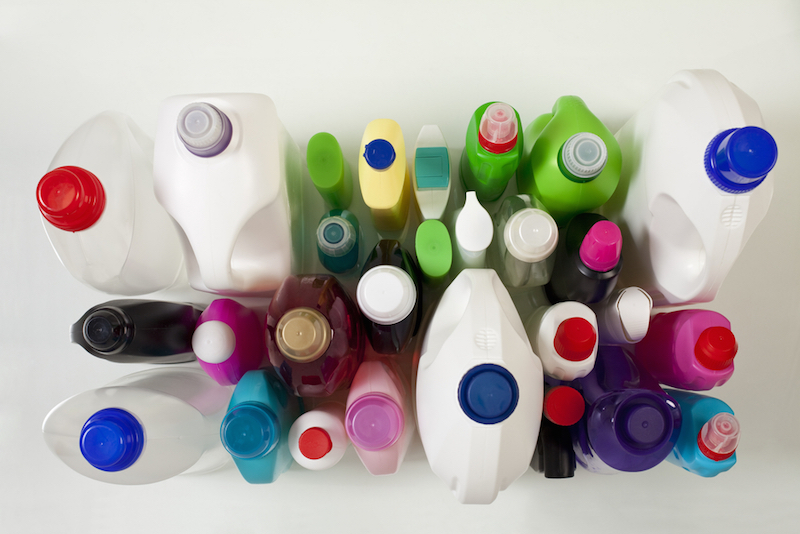Environment
How does the United States regulate citizen exposure to harmful chemicals?

Image: crabgarden/Shutterstock
With more than 85,000 chemicals in use in the United States today, many of which are contained in our everyday household products, one would think regulations would have long been sufficiently in place to ensure their safety. Think again. While chemical safety laws have existed, calls for their modernization have grown—and been answered—amidst realizations that they are actually quite insufficient, outdated and “toothless.”
What’s the problem?
The first issue at hand is understanding the law. The Toxic Substances Control Act (TSCA), or “TOSCA,” as many call it, was set up in 1976 to protect consumers after a series of chemical hazard concerns occurred. According to the U.S. Environmental Protection Agency website, TSCA allows the EPA the authority to “require reporting, record-keeping and testing requirements, and restrictions relating to chemical substances and/or mixtures. Certain substances are generally excluded from TSCA, including, among others, food, drugs, cosmetics and pesticides. TSCA addresses the production, importation, use and disposal of specific chemicals including polychlorinated biphenyls (PCBs), asbestos, radon and lead-based paint.” Interestingly, there has long been a list kept under this law which includes the names of every chemical manufactured or brought into the United States—without any judgment whatsoever beside it as to its safety or toxicity.
Concerns about chemical regulations have grown greater still after a recent study published in the October The Lancet journal pointed out that endocrine-disrupting chemicals cost the U.S. billions annually in the form of illness and lost productivity. Blood and urine samples from the Center for Disease Control and Prevention (CDC) were used in the study, and were found to contain “flame retardants like PBDEs, phthalates, widely used in cosmetics and scented products, the plastic component DEHP, and organophosphate pesticides, (which) are among the chemicals linked to health issues in the U.S.,” according to Time magazine’s report on the research.
Further findings in the study included a disease cost comparison between the United States and Europe in regard to chemical exposure. A substantially lower cost related to chemical exposure was highlighted in Europe, with a total of $217 billion, compared to the United States’ whopping $340 billion, but neither are ideal. One difference in particular was related to diminished IQ points and intellectual disability in the United States due to widespread exposure to polybrominated diphenyl ethers, or PBDEs, a flame retardant found in numerous household items and furnishings, plastics, electronics and building materials. Other dangers linked to chemical exposure include risks of obesity, endometriosis, autism, and heart disease. According to New York University professor Leonardo Trasande, an author of the study, “Exposures in the United States are similar in some ways, but they also differ. That’s in large part to differences in regulation between Europe and the U.S.”
Why have regulations been so poor?
When TSCA was first implemented, many compounds that existed prior to its drafting were “grandfathered” into the system without ever being tested for safety. The way TSCA was written precluded them from being tested, so around 62,000 chemicals remained in our environment and homes exposing us to unknown hazards without investigation, and are still there, continuing to be produced and used in our products. The only requirement of chemical manufacturers until recent changes is that they must submit information about new chemicals regarding their “production, use, exposure and environmental fate”—not the older ones, even if widely-used. In addition, new chemicals must be proven to pose an “unreasonable risk,” according to Chemistry World’s June edition, before a request for more information can even be made. How would anyone know if there’s an “unreasonable risk” before the additional information was requested, you ask? That is exactly the conundrum, and one the chemical industry surely has benefitted from the most until now—at the expense of our health.
Although TSCA did earn a few achievements in the past forty years, it’s essentially every bit as toothless as its accusers describe. Only around 200 chemicals were tested under its name, but it has close to 85,000 chemicals identified on its big, information-less list. Only five bans (or noteworthy restrictions) actually occurred on chemicals, including halogenated solvents in aerosols, dioxin waste, hexavalent chromium in air conditioners, asbestos and polychlorinated biphenyls—and three fluids related to metal working were also restricted. Later, however, asbestos proponents came back swinging and overturned the ruling on the ban in 1991, complaining that there was a “lack of evidence” to implement such a widespread ban. The proven carcinogen is not banned in the U.S. for that reason—TSCA only ensured that new asbestos material could not be used. The old stuff can hang out indefinitely.
With the limitations of TSCA being more widely known, several states’ laws, with California leading the way, have jumped in to protect their citizens. However, by some lawmakers’ perspectives, these laws are creating confusing patterns throughout the nation on what it is and is not allowed to pass the borders of over eighteen states. A greater insistence from some on modernizing TSCA arose, and a new federal law has been signed to heed the call.
The new law, signed by President Obama in June, “sets safety standards for dangerous chemicals like formaldehyde, asbestos and styrene, and aims to standardize on the national level what is currently a jumble of state rules governing the $800 billion-per-year industry.” A revision of the 1976 TSCA, the new law was backed by the American Chemistry Council and is said to, “bring chemical regulation into the 21st century.” Says Obama himself, “Folks should have the confidence to know the laundry detergent we buy isn’t going to make us sick, the mattress our babies sleep on isn’t going to harm them.” Some Republicans opposed the legislation and referred to it as “an overzealous Washington takeover of a matter they said should be left to the states.”
However, it’s not just the Republicans who have concerns. Even some environmental groups seem less than enthused by the president’s signing of such a law as well. The Intercept reported in June that the Frank R. Lautenberg Chemical Safety for the 21st Century Act, which Obama signed, in addition to the House bill, or TSCA Modernization Act combined, “makes it much harder for states to regulate chemicals after the EPA has evaluated them, and would even prohibit states from acting while the federal agency is in the process of investigating certain chemicals.” Therefore, chemical safety laws set in place by environmentally-conscious states like Oregon, Maine, Vermont, California, Washington and Minnesota may become nullified by this act, robbing them of their state right to make their citizens safe from chemicals. Any work in process for those protections on the state level would be required to stop immediately and the federal findings on chemical safety would overrule.
What else will the new law promise to do?
The revised law should give the EPA stronger power to gather information on chemicals and require all chemicals currently on the market to submit to a safety review, safety tests and be held to strict deadlines on all of it—imposing the tightest due dates on chemicals of greatest concern. It’s similar to the EU’s ‘Reach’ regulations, only in the United States the EPA would be responsible for the testing and safety assurances of chemicals while in the EU those tasks remain the burden of industry to prove.
In regard to certain companies concealing chemicals as “proprietary,” (as discussed at length in the recent documentary on the danger of fragrance chemicals, ‘STINK’), the new law creates greater difficulty categorizing chemicals as “trade secrets” or “proprietary” in favor of transparency for the benefit and health of the people being exposed.
While this all sounds great, there still are many valid concerns about how long it will take to test all the relevant chemicals, how much it will cost the EPA and whether it will continue to diminish individual state rights as well as individuals’ rights to sue for damages if harmed by products. Aside from those issues, the American Chemistry Council, which lobbies for the chemical manufacturing companies, has been critical of the study for linking household chemicals to endocrine disruption without proving causation. The connection appears to remain correlational for many chemicals’ to endocrine damage, but people such as Trasande insist that regardless of industry complaints, the burden of proving safety should rest with the company producing and benefiting monetarily from the chemicals, and not be passed onto regulatory agencies funded by consumer tax dollars.
In most recent news on the subject, the National Law Review shares that companies which do not submit their updated chemical information to the EPA using proper means by the now-extended deadline of October 31, 2016, may be given penalties or other enforcement action on the delay. How this, and other events, play out concerning the chemical industry and consumer safety on the state and federal levels is definitely worth a steady and watchful citizen’s eye.





0 comments